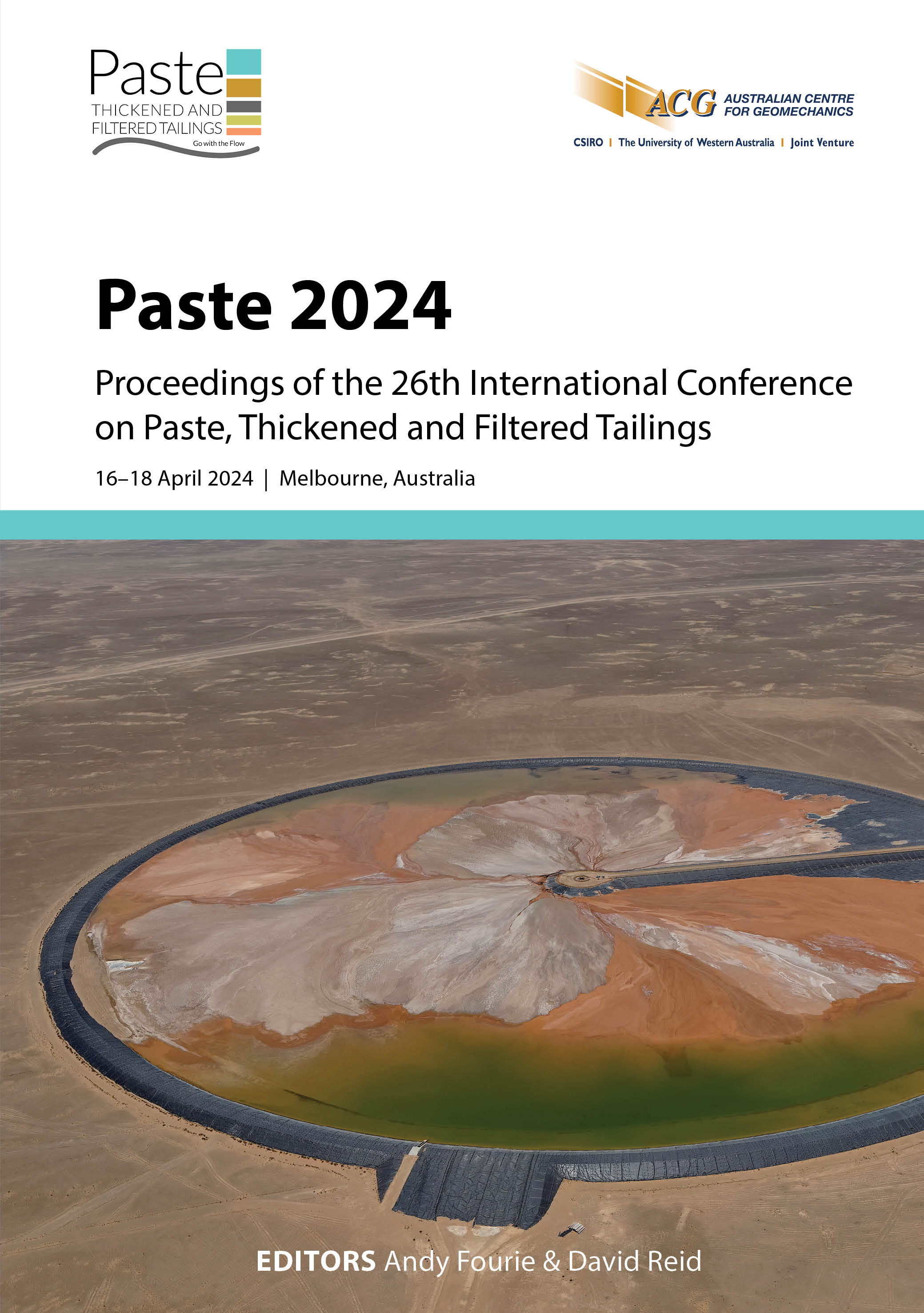Admixture impact on rheological properties of a calcined clay binder for cemented paste backfill

|
Authors: Dhers, S; Freimut, D; Martic, Z; Salter, R |
DOI https://doi.org/10.36487/ACG_repo/2455_09
Cite As:
Dhers, S, Freimut, D, Martic, Z & Salter, R 2024, 'Admixture impact on rheological properties of a calcined clay binder for cemented paste backfill', in AB Fourie & D Reid (eds), Paste 2024: Proceedings of the 26th International Conference on Paste, Thickened and Filtered Tailings, Australian Centre for Geomechanics, Perth, pp. 131-138, https://doi.org/10.36487/ACG_repo/2455_09
Abstract:
Calcined clays appear to be one of the most promising supplementary cementitious materials to reduce the CO2 footprint of cement, in particular the limestone calcined clay combination known as limestone calcined clay cement (LC3). New and improved admixtures with tailored properties are necessary to ensure a broad implementation of LC3 in the mining industry, to reach net zero. This study investigates the time-dependent rheological behaviour of cemented paste backfill (CPB) that contains calcined clay as a binder, using three admixtures, amongst which one is part of the Intelligent Cluster System (ICS) for low-clinker concrete technology. Yield stress and plastic viscosity have been reported and highlights the impact of the admixtures. A cradle-to-gate lifecycle assessment comparison between CEM I and the LC3-35 binder (LC3-35, containing 40% calcined clay, 20% limestone) is also detailed in this work. This study evidences the readiness of calcined clay binders for CPB, using the adequate high-performing admixtures.
Keywords: cemented paste backfill, superplasticiser, calcined clay, LC3, rheology, compressive strength
References:
Avet, F., Snellings, R, Diaz, AA, Haha, MB & Scrivener, K 2016, ‘Development of a new rapid, relevant and reliable (R3) test method to evaluate the pozzolanic reactivity of calcined kaolinitic clays’, Cement and Concrete Research, vol. 85, pp. 1–11.
Bahhou, A, Taha, Y, Khessaimi, YE, Idrissi, H, Hakkou, R, Amalik, J & Benzaazoua, M 2021, ‘Use of phosphate mine by-products as supplementary cementitious materials’, Materials Today, vol. 37, pp. 3781–3788.
Belem, T & Benzaazoua, M 2008, ‘Design and application of underground mine paste backfill technology’, Geotechnical and Geological Engineering, vol. 26, pp. 147–174.
Diaz-Loya, I, Juenger, M, Seraj, S & Minkara, R 2019, ‘Extending supplementary cementitious material resources: reclaimed and remediated fly ash and natural pozzolans’, Cement and Concrete Composites, vol. 101, pp. 44–51.
Dhers, S, Guggenberger, R, Freimut, D, Fataei, S, Schwesig, P & Martic, Z 2023, ‘Impact of admixtures on environmental footprint, rheological and mechanical properties of LC3 cemented paste backfill systems’, Minerals, vol. 13, no. 12, pp. 1552.
Fall, M, Benzaazoua, M & Belem, T 2016, ‘A review of sustainable cemented paste backfill practices based on strength and environmental considerations’, Minerals, vol. 6, pp. 37.
Hache, E, Simoën, M, Seck, GS, Bonnet, C, Jabberi, A & Carcanague, S 2020, ‘The impact of future power generation on cement demand: An international and regional assessment based on climate scenarios’, International Economics, vol. 163, pp. 114–133.
Hassani, F, Razavi, SM & Isagon, I 2007, ‘A study of physical and mechanical behaviour of gelfill’, CIM Bulletin, vol. 100, pp. 1–7.
Ouattara, D, Mbonimpa, M, Yahia, A & Belem, T 2018, ‘Assessment of rheological parameters of high density cemented paste backfill mixtures incorporating superplasticizers’, Construction and Building Materials, vol. 190, pp. 294–307.
Scrivener, K, Martirena, F, Bishnoi, S & Maity, S 2018, ‘Calcined clay limestone cements (LC3)’, Cement and Concrete Research, vol. 14, pp. 49–56.
Scrivener, K, Avet, F, Maraghechi, H, Zunino, F, Ston, J, Hanpongpun, W & Favier, A 2019a, ‘Impacting factors and properties of limestone calcined clay cements (LC3)’, Green Materials, vol. 7, pp. 3–14.
Scrivener, K, Dekeukelaere, A, Avet, F & Grimmeissen, L 2019b, Financial attractiveness of LC3, École Polytechnique Fédérale de Lausanne, Lausanne.
Song, X, Pettersen, JB, Pedersen, KB & Røberg, S 2017, ‘Comparative life cycle assessment of tailings management and energy scenarios for a copper ore mine: A case study in Northern Norway’, Journal of Cleaner Production, vol. 164, pp. 892–904.
Wei, M, Kong, X & Huang, J 2022, ‘Current status and suggestions for the disposal of tailing waste in China’, Chemical Mineralogy Processing, vol. 5, pp. 34–38.
Yan, B, Zhu, W, Hou, C, Yilmaz, E & Saadat, M 2020, ‘Characterization of early age behavior of cemented paste backfill through the magnitude and frequency spectrum of ultrasonic P-wave’, Construction and Building Materials, vol. 249, pp. 118733.
Zieri, W & Ismail, I 2019, ‘Alternative fuels from waste products in cement industry’, in LMT Martínez, OV Kharissova & BI Kharisov (eds), Handbook of Ecomaterials, Springer International Publishing, Cham, pp. 1183–1206.
© Copyright 2025, Australian Centre for Geomechanics (ACG), The University of Western Australia. All rights reserved.
View copyright/legal information
Please direct any queries or error reports to repository-acg@uwa.edu.au
View copyright/legal information
Please direct any queries or error reports to repository-acg@uwa.edu.au
